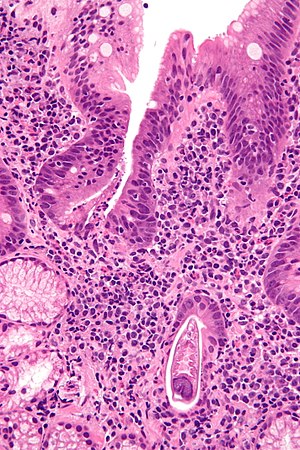Strongyloidiasis
| Strongyloidiasis | |
|---|---|
 |
|
| Micrograph showing strongyloidiasis; a fragment of a worm is seen in the lower right hand corner. H&E stain. | |
| Classification and external resources | |
| Specialty | infectious disease |
| ICD-10 | B78 |
| ICD-9-CM | 127.2 |
| DiseasesDB | 12559 |
| MedlinePlus | 000630 |
| eMedicine | article/999614-overview |
| Patient UK | Strongyloidiasis |
| MeSH | D013322 |
Strongyloidiasis is a human parasitic disease caused by the nematode (roundworm) called Strongyloides stercoralis, or sometimes S. fülleborni which is a type of helminth. It belongs to a group of nematodes called roundworms. This intestinal worm can cause a number of symptoms in people, principally skin symptoms, abdominal pain, diarrhea and weight loss. In some people, particularly those who require corticosteroids or other immunosuppressive medication, Strongyloides can cause a hyperinfection syndrome that can lead to death if untreated. The diagnosis is made by blood and stool tests. The medication ivermectin is widely used to treat strongyloidiasis.
Strongyloidiasis is a type of soil-transmitted helminthiasis. It is thought to affect 30–100 million people worldwide, mainly in tropical and subtropical countries. It belongs to the group of neglected tropical diseases, and worldwide efforts are aimed at eradicating the infection.
Strongyloides infection occurs in five forms. On acquiring the infection, there may be respiratory symptoms (Löffler's syndrome). The infection may then become chronic with mainly digestive symptoms. On reinfection (when larvae migrate through the body), there may be respiratory, skin and digestive symptoms. Finally, the hyperinfection syndrome causes symptoms in many organ systems, including the central nervous system.
Frequently asymptomatic. Gastrointestinal system symptoms include abdominal pain and diarrhea. Pulmonary symptoms (including Löffler's syndrome) can occur during pulmonary migration of the filariform larvae. Dermatologic manifestations include urticarial rashes in the buttocks and waist areas as well as larva currens.Eosinophilia is generally present.
...
Wikipedia
